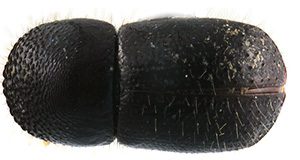Ambrosiodmus minor is an invasive ambrosia beetle in the southeastern United States, including Florida. It is considered of low importance because evident economic or ecological impacts have not been observed. However, it is associated with a unique ambrosia fungus, Flavodon subulatus, which causes rapid wood rot. Wood decay caused by this association between Ambrosiodmus and Flavodon is increasing in dead trees across the introduced range, especially in Florida. This 4-page fact sheet written by Demian F. Gomez and Jiri Hulcr and published by the UF/IFAS School of Forest Resources and Conservation offers guidance in identification of the pest, the symptoms of an infestation, and explanation of the insect’s biology. In addition, we provide an updated overview of contemporary management and monitoring of the species.
https://edis.ifas.ufl.edu/fr434
Tag: Demian F. Gomez
The invasive shot hole borers Euwallacea fornicatus, E. kuroshio, and E. perbrevis (Coleoptera: Curculionidae: Scolytinae)
Invasive species, those that are nonnative and cause economic damage, are one of the main threats to ecosystems around the world. Ambrosia beetles are some of the most common invasive insects. Currently, severe economic impacts have been increasingly reported for all the invasive shot hole borers in South Africa, California, Israel, and throughout Asia. This 7-page fact sheet written by Demian F. Gomez, Jiri Hulcr, and Daniel Carrillo and published by the School of Forest Resources and Conservation describes shot hole borers and their biology and hosts and lists some strategies for prevention and control of these pests.
http://edis.ifas.ufl.edu/fr422
The Southern Pine Beetle Dendroctonus frontalis (Coleoptera: Curculionidae: Scolytinae)
The southern pine beetle, Dendroctonus frontalis Zimmermann, is the most destructive insect pest of pine in the southern United States. This 8-page fact sheet written by Demian F. Gomez and Jiri Hulcr and published by the UF/IFAS Department of Entomology and Nematology describes the beetle and includes advice on how to monitor for them and strategies for their prevention and control.
http://edis.ifas.ufl.edu/in333


